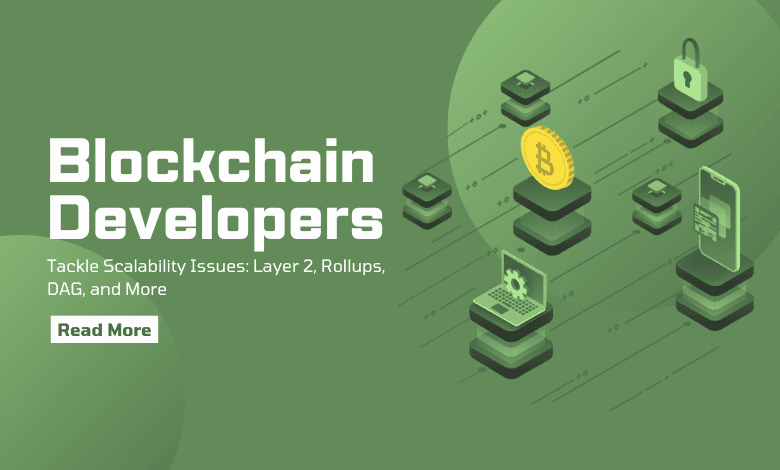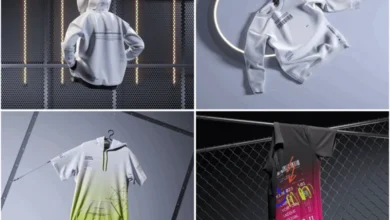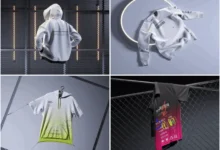How Blockchain Developers Tackle Scalability Issues: Layer 2, Rollups, DAG, and More

If you’ve spent any time in the blockchain space, you’re probably familiar with scalability concerns. It’s a huge challenge for developers, miners, and anyone trying to scale blockchain systems. Simply put, scalability is the ability of a blockchain to handle an increasing number of transactions as it grows. And let’s be honest, we’re still figuring out the best way to do it. So how are developers addressing scalability? Let’s dive into some cool technologies like Layer 2 solutions, Rollups, Directed Acyclic Graphs (DAG), and other innovations that are giving blockchain a much-needed boost.
1. What Exactly Is Blockchain Scalability?
Let’s start by clarifying what scalability means in the world of blockchain. When you send a transaction on a network like Ethereum, the system needs to process and verify that transaction. Sounds simple, right? But when more people jump onto the network (like what happened with the DeFi boom in 2021), things start to slow down, causing high gas fees and longer wait times. Scalability is all about how well a blockchain can manage an increasing number of transactions as more users join.
Here’s an interesting comparison: Ethereum handles around 30-45 transactions per second (TPS), while Visa processes up to 65,000 TPS. Yeah, blockchain has some catching up to do! Even Bitcoin can only manage about 7 transactions per second.
The Blockchain Trilemma
Here’s the tricky part: developers face a well-known “trilemma” when working with blockchain. They must balance security, decentralization, and scalability. It’s like trying to juggle three objects, except they’re all heavy. You can’t perfectly balance all three at once. So, what’s the answer? If you’re searching for a reliable blockchain development company Boosty Labs is one that specializes in solving this very problem by offering solutions that balance all three efficiently. Let’s take a closer look at some strategies.
2. Layer 2 Solutions: Blockchain’s Speed Boosters
Think of building a house with just a hammer—it’s possible, but it would take forever. Now, imagine having a full set of tools that can speed up the process. That’s essentially what Layer 2 solutions do for blockchain. They work on top of the base blockchain (Layer 1) to accelerate transactions without altering the original system. Let’s look at some of the most popular Layer 2 options.
State Channels: Private Pathways for Transactions
State Channels are like private lanes for two users to transact off-chain. Instead of recording every single transaction on the main blockchain, these channels allow users to complete transactions privately, and only the final result is submitted to the main chain. This significantly eases congestion.
A great example? The Bitcoin Lightning Network lets users send payments instantly without congesting the Bitcoin network.
Interesting fact: Since 2020, the Lightning Network’s capacity has increased by 500%, with over 3,000 BTC transacted through it.
Plasma: Efficient Transaction Bundles
Plasma is another clever tool—it gathers multiple transactions into one neat package and submits them to the main blockchain in bulk. This reduces the overall strain on the network.
Ethereum is incorporating Plasma as part of its strategy to scale and process up to 1 million transactions per second.
Sidechains: Independent Lanes for Blockchain Traffic
Sidechains are like separate highways running parallel to the main blockchain. They handle transactions independently but still remain connected to the primary chain.
An example of this is Polygon, which acts as a sidechain for Ethereum, helping it scale with faster and more affordable transactions. Polygon is currently processing over 7.5 million transactions daily.
3. Rollups: Speeding Up Transactions by Bundling
If Layer 2 solutions are like helpful sidekicks, then Rollups are the superheroes. Rollups work by bundling several transactions into one, which alleviates the strain on the main chain. There are two main types: Optimistic Rollups and ZK-Rollups.
Optimistic Rollups: Trust, But Verify
Optimistic Rollups assume that all transactions are valid and only check them if there’s a dispute. This makes them faster since they don’t need to verify every transaction upfront.
Optimism, built on Ethereum, is a good example. Since launching in 2021, it has boosted Ethereum’s scalability by processing over 40% more transactions without slowing the network.
ZK-Rollups: Privacy Meets Speed
ZK-Rollups use zero-knowledge proofs to validate transactions without revealing sensitive details. This makes transactions not only faster but also more secure and private.
zkSync is using ZK-Rollups to scale Ethereum, and the results are impressive—transaction fees are now over 90% lower compared to Ethereum’s main network.
4. Directed Acyclic Graph (DAG): Scaling Blockchain in a New Way
Let’s switch gears and talk about Directed Acyclic Graphs (DAG). This isn’t your typical blockchain. Instead of a single chain of blocks, DAG allows transactions to be processed in parallel. Think of a busy street where cars (transactions) can move without waiting in line.
How DAG Works
Instead of following a linear chain, DAG allows transactions to connect in a non-circular, directed graph. Each new transaction confirms the previous ones, allowing faster and more scalable processing.
IOTA is one of the most famous projects using DAG with its Tangle structure. IOTA’s Tangle can handle millions of transactions per second and even keeps transaction fees at zero.
In 2021, IOTA’s Chrysalis upgrade increased network speed by over 10 times, allowing it to process 12,000 transactions per second.
5. Sharding: Splitting the Blockchain to Scale
Sharding is another method, which breaks the blockchain into smaller pieces (shards). Each shard processes its own set of transactions, allowing the network to handle more data simultaneously. It’s like dividing a large project among several workers instead of relying on one person.
Sharding in Action
Ethereum’s Ethereum 2.0 upgrade plans to introduce sharding as it transitions from Proof of Work to Proof of Stake. This will allow Ethereum to process thousands of transactions per second, a major jump from its current capacity of 30.
Zilliqa, a blockchain that adopted sharding early on, can currently process 2,828 transactions per second, making it one of the fastest blockchains.
6. Hybrid Solutions: The Best of Both Worlds
As you can imagine, no single solution is perfect. That’s why many developers are combining various technologies to create new and improved ways to scale blockchain.
Mixing Layer 2, Rollups, and Sharding
Take Polkadot, for example. It combines sharding with cross-chain interoperability to create a multi-chain network that scales effortlessly. Each shard processes its own transactions, but the whole network stays connected.
Ethereum is another great example, where projects like Polygon combine Layer 2 (sidechains), Rollups, and other scaling solutions to create a hybrid approach that enhances efficiency and cuts costs. By 2025, hybrid blockchain solutions are expected to make up over 40% of blockchain projects, offering more flexibility and scalability.
7. Consensus Mechanisms and Their Impact on Scalability
The consensus mechanism, like Proof of Work (PoW) and Proof of Stake (PoS), is also key to scalability. PoW (used by Bitcoin) requires miners to validate transactions, which is slow and energy-intensive. PoS (used by Ethereum 2.0) lets validators process transactions faster, improving scalability.
For example, Cardano, a PoS blockchain, can process 250 transactions per second, compared to Bitcoin’s 7. Solana, with its unique Proof of History (PoH) mechanism, can handle 65,000 transactions per second—now that’s speed!
8. The Road Ahead: Opportunities and Obstacles
Where are we headed with scalability? The future holds a lot of exciting possibilities, though there are still some challenges to overcome. Issues like decentralization and data availability (ensuring transactions are recorded and verifiable) still need to be addressed.
But the bright side is that technologies like sharding, Layer 2, and Rollups are making great strides. As blockchain technology matures, we’re likely to see faster, more affordable, and scalable networks.
9. Conclusion: Blockchain Scaling—A Marathon, Not a Sprint
Blockchain scalability may be one of the toughest problems in tech today, but it’s also one of the most thrilling to solve. Whether through Layer 2, Rollups, DAG, or sharding, developers are coming up with innovative solutions that push past current limits.
Blockchain networks are growing faster than ever, and with these breakthroughs, the future is looking a whole lot brighter. So, hang on tight! The scalability revolution is just getting started.
Hungry for more words? Dive into www.wordplop.com and keep the learning going!






